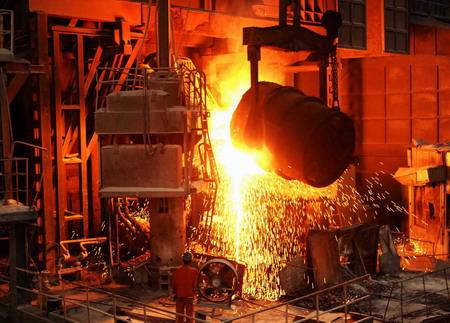BEIJING, Jan. 22 (Xinhua) -- Supply-side structural reform will continue to be a priority of provincial governments this year as China resolves to press ahead with the major tasks for reform amid downward pressure.
New targets in cutting excess capacity in major sectors such as steel and coal have been set this year, as unveiled at the annual sessions of provincial legislatures held in January.
The local sessions, which review and approve government economic and social development blueprints, come ahead of the annual sessions of the national legislature and the top political advisory body in March.
After a reduction of 33 million tonnes of steel capacity last year, China's northern Hebei Province, aims to further slash about 32 million tonnes of steel capacity this year, according to the provincial government work report earlier this month.
"2017 will be our toughest year in capacity reduction. No matter how difficult it is, we are determined to succeed," said governor Zhang Qingwei. Hebei produces a quarter of the country's iron and steel.
Yu Yong, chairman of Hesteel Group, the largest steel firm in Hebei, said "properly cutting capacity will make room for restructuring and upgrading of the steel sector."
The company cut 3.2 million tonnes of iron and steel capacity last year and targets a reduction of 4.4 million tonnes this year.
Coal-rich Shanxi and central Henan both set the targets of cutting 20 million tonnes of coal capacity this year. The two provinces each slashed 23 million tonnes of coal capacity last year.
"Coal overcapacity reduction should be achieved through market and law-based means," said Lou Yangsheng, governor of Shanxi, adding that mergers and reorganizations would be encouraged.
Central Hubei Province said that it would close all its coal production firms in two years. Southwestern Guizhou Province will slash 15 million tonnes of coal capacity by closing 120 coal mines this year.
As part of the reform, local governments will also focus on handling poor-performing zombie companies.
Eastern Zhejiang Province plans to close 300 zombie companies and 1,000 firms with outdated capacity this year. Southern Guangdong Province aims to close 74 private zombie firms after it closed more than 2,000 state-owned zombie companies and 39 private companies in 2016.
China achieved its 2016 target of cutting 45 million tonnes of steel and 250 million tonnes of coal production capacity, affecting nearly 800,000 workers.
This year the tasks will be heavier, and zombie companies will be focused on, according to Xu Shaoshi, head of the National Development and Reform Commission, the country's top economic planner.
So far, 27 provinces have unveiled growth rates for last year and their targets for 2017 at local annual legislative sessions.
Among them, 23 had growth rates higher than the national 6.7 percent,with the southwestern Guizhou, Chongqing and Tibet all above 10 percent. Beijing and Shanghai both reported 6.7 percent.
Most of the provinces aim to maintain the same or slightly lower growth than in 2016.
With an estimated growth of 4.5 percent in 2016, lower than most other provinces, Shanxi set its GDP growth target at 5.5 percent this year to "leave wiggle room for transformation and reform."
Other reforms, such as market-oriented debt-for-equity swaps and administrative streamlining, are emphasized by many provinces to reduce corporate leverage and encourage businesses.
Besides the structural reform in industry, China also emphasized reform in agriculture this year.
Henan, a traditional agricultural province, said it would focus on cultivating quality wheat, peanuts and fruit, as well as fostering leading agricultural processing enterprises this year.
"More efforts should be made to improve the quality of agricultural products to meet the consumption demand of citizens," said Wang Hongwei, a local lawmaker and entrepreneur.




 A single purchase
A single purchase









